Poecilasthena cisseres is a moth of the family Geometridae first described by Alfred Jefferis Turner in 1933. It is found in Australia, including Victoria.
Cyclotorna egena is a moth of the family Cyclotornidae. It is found in Australia, including New South Wales and Queensland.
Hexadactilia civilis is a moth of the family Pterophoridae. It is found in Queensland, Australia.

Sphenarches zanclistes is a moth of the family Pterophoridae that is found in Australia.
Batrachedra plagiocentra is a species of moth of the family Batrachedridae. It is found in Australia.
Eublemma rufipuncta is a moth of the family Noctuidae first described by Alfred Jefferis Turner in 1902. It is found in Australia.

Amblyptilia epotis is a moth of the family Pterophoridae. It is endemic to New Zealand and is found in the South and Stewart Islands. It inhabits mountainous terrain covered in alpine vegetation or alternatively alpine wetland habitat. The adults of this species are on the wing from February to March. In appearance the adults of this species are variable in colour however this species can be distinguished from similar species by the oblique apical streak on its forewings as well as the patch of white on the costa cilia towards the apex of the forewing.
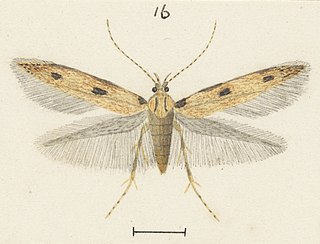
Labdia anarithma is a moth of the family Cosmopterigidae. It was described by Edward Meyrick in 1888. It is found in New Zealand and throughout Australia. Adults are on the wing from December to March and are day flying. They have been collected by sweeping bracken fern.
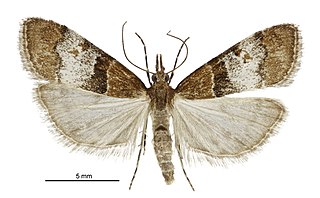
Antiscopa acompa is a moth in the family Crambidae. It was first described by Edward Meyrick in 1884. It is endemic to New Zealand and is found both the North and South Islands. The species inhabits native forest and adult moths are attracted to light.

Tingena ancogramma is a species of moth in the family Oecophoridae. It is endemic to New Zealand and has been found in the Hen and Chicken Islands, the North Island and the South Island. Adults are on the wing in summer and autumn and inhabit open areas of forest scrubland.
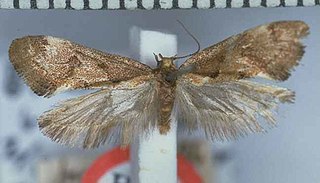
Tingena brachyacma is a species of moth in the family Oecophoridae. It is endemic to New Zealand and has been found in the south of the South Island. This species inhabits open swamps, native forest and scrubland and has been collected amongst Leptospermum. The adults of the species are on the wing in November and December.
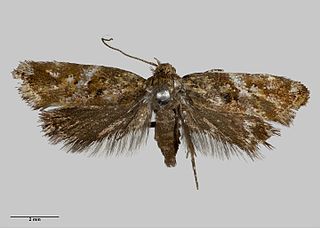
Tingena eumenopa is a species of moth in the family Oecophoridae. It is endemic to New Zealand and found in the North and South Islands. The adults have been found amongst tree ferns and are on the wing in December.

Tingena homodoxa is a species of moth in the family Oecophoridae. It is endemic to New Zealand and is found in the southern parts of the South Island. It inhabits open grassy slopes and is on the wing from November until January.

Tingena horaea is a species of moth in the family Oecophoridae. It is endemic to New Zealand and have been observed in both the North and South Islands. The adults are on the wing in January.
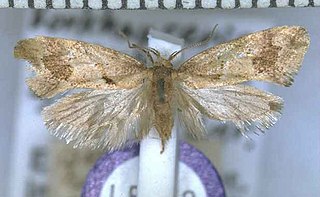
Tingena penthalea is a species of moth in the family Oecophoridae. It is endemic to New Zealand and has been observed in Wellington and the Tararua Range. The adults of this species are on the wing from December until February.
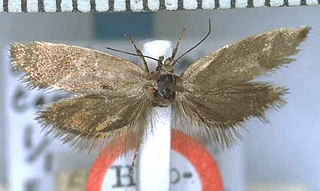
Tingena tephrophanes is a species of moth in the family Oecophoridae. It is endemic to New Zealand and has been found at Mount Arthur. Adults of this species are on the wing in January.

Dasyuris fulminea is a species of moth in the family Geometridae. It was first described by Alfred Philpott and is endemic to New Zealand. It has been observed in the regions of the West Coast, Fiordland and Otago. Adults are day flying and are on the wing from December until February.

Atomotricha isogama is a moth in the family Oecophoridae. It was first described by Edward Meyrick in 1909. This species is endemic to New Zealand and has been observed in the North and South Islands. Larvae are leaf litter feeders and have been recorded as emerging in the New Zealand spring. Adults have been observed on the wing from July to January.

Trachypepla ingenua is a moth of the family Oecophoridae first described by Edward Meyrick in 1911. It is endemic to New Zealand and has been collected in both the North and South Islands. This species is one of the larger in the genus Trachypepla and the colouration of the adults imitates bird droppings. The preferred habitat of T. ingenua is native forest and adults are on the wing from December to February.

Trachypepla photinella is a moth of the family Oecophoridae first described by Edward Meyrick in 1883. It is endemic to New Zealand and has been collected in Wellington, Wainuiomata, D'Urville Island and Christchurch. The preferred habitat of this species is native forest and adults are on the wing from December until February.
This page is based on this
Wikipedia article Text is available under the
CC BY-SA 4.0 license; additional terms may apply.
Images, videos and audio are available under their respective licenses.














